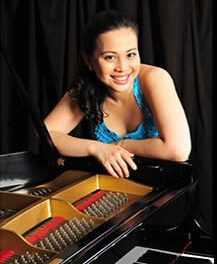Music lovers owe a debt of gratitude to NC School of the Arts Music Director Serge Zehnacker for programming two rarities on the April 22 orchestra concert, given in Stevens Center. Student concerto competition winners were featured in unjustly neglected works.
Swiss-born Frank Martin (1890-1974) was a slow developer as a composer. A performance of Bach’s St. Matthew Passion was a searing experience for the 12-year-old Martin, and the German composer’s harmony remained an influence the remainder of his life. According to Bernhard Billeter, in Grove Music Online, “all (of) his life (Martin) considered harmony to be the most important musical element.” Aspects of the styles of Schumann, Chopin, and especially Franck played major roles in the evolution of Martin’s mature style, heard first in the secular oratorio Le vin herbé, which was set to a text taken from Joseph Bédier’s novel Tristan et Iseut (1938-41). About this time, as part of his conservatory job, Martin composed a series of ballads for solo instrument and piano or orchestra. The Ballade for Flute and Strings (1941) was originally composed with piano accompaniment in 1939. Billeter describes the general form of all the ballads as being in “one movement…, in several sections,” and rhapsodic in form.
David Graham, a senior from Butler, Pennsylvania, was a most winning flute soloist. His flute has a gold mouthpiece, and he produced an immaculate and seamless line graced by warm tone and a refined sense of color. The fastest runs were clearly articulated, and his breath control was remarkable. Zehnacker secured a carefully balanced and delicate orchestral accompaniment. Graham’s primary teachers have been Stacey Steele and Tadeu Coelho.
In a just world, Prokofiev’s Symphony-Concerto for Cello and Orchestra, Op. 125, would be heard as often as the concertos of Dvorák and Elgar. The composer began the work in 1938, and its premiere was a disaster. In 1947, the then-20-year old Mstislav Rostropovich revived it after Prokofiev revised the score extensively. It combines the composer’s astringent and tart style with a newly developed simple lyricism. The brash and pungent first and third movements surround the heart of the work, the Allegro giusto, which demands considerable virtuosity, not least during the headlong near-perpetual motion conclusion of the movement. There are many brief but important solos for numerous principal players. According to Rostropovich (quoted in notes for the EMI CD set “Rostropovich: The Russian Years, 1950-1974”), “in the finale…, Prokofiev incorporated a theme that was similar to a popular song by Vladimir Zakharov, an apparatchik who mercilessly vilified all ‘formalists’ targeted by the Stalinists.”
Bulgarian-born Lachezar Kostov, a student of Zvi Plesser, played with astonishing maturity, clearly making the concerto his own. His intonation was excellent and he conjured a deep and robust tone from his cello. The awesome purity of his playing of exposed high harmonics was staggering, and his bowing and fingering of breakneck passages were wonders to see. Zehnacker brought out all the motoric quality of Prokofiev’s score along with its kaleidoscopic colors without even once covering his soloist. In an unusual but heart-warming gesture, Kostov signaled for his student musician colleagues to stand and thereby be honored for their important solos.
A few professional players from the Greensboro Symphony and NC Symphony and some freelancers manned rear string stands to help provide a full and rich sound for Brahms’ Symphony No. 4 in E Minor, Op. 98. As they had throughout the concerto portion of the evening, the NCSA student musicians played with the utmost professionalism. Ensemble was tight, with everyone in a section playing as one, responding instantly to the slightest change of tempo or rhythm. Zehnacker led as fine an interpretation of the Brahms as I have heard in thirty years. Every choice of tempo and every choice of phrasing seemed so right. Bravo!












